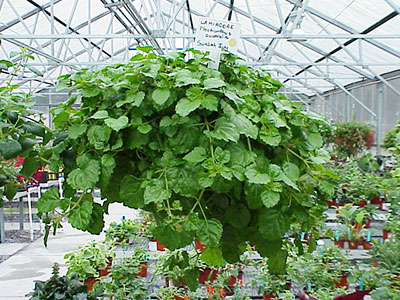Swedish Ivy

Swedish ivy has been popular as a houseplant for many years, and for good reason. The ideal beginners’ plant, it thrives in a range of soil, watering, and light conditions.
Swedish ivy looks best in a hanging basket, which allows its trailing branches to drape gracefully. As an indoor plant, it prefers bright light, but outdoors it must be kept in the shade—direct sun burns the leaves.
Characteristics
Most varieties of Swedish ivy (Plectranthus australis) have glossy green leaves with scalloped edges; the ‘Variegata’ selection has white markings along the edges of the leaves providing an attractive accent to the green. Swedish ivy produces white or light purple blooms off and on throughout the year.
Planting and Care
Plant Swedish ivy in any good quality well drained potting media. When the top inch of the soil feels dry to the touch, water your plant well, but never let it sit in water.
Swedish ivy does best in average temperatures and moderate light year-round. During the winter, this plant can tolerate lower temperatures (40 degrees and up) for short periods of time, but it will need to be brought indoors to protect it from freezing temperatures.
Pruning your plant is an important part of encouraging new growth. When flowers fade, pinch back the stems to encourage new growth and branching; individual stems can also be pruned at any time of the year. Swedish ivy’s tolerance of even severe pruning is another reason why it’s a great plant for beginners.
If your Swedish ivy isn’t looking as healthy as it once did, there are some easy ways to troubleshoot your problems:
- Leaves are dull and droopy – It’s likely your plant is receiving too much light and should be moved to a shadier location.
- Not blooming – A lack of blooms can be caused by too much nitrogen fertilizer and/or insufficient light. To get your Swedish ivy blooming again, switch to a high phosphorous (low nitrogen) fertilizer during spring and move your plant to an area where it receives more natural light.
- Wilting – If your entire Swedish ivy plant is wilting, and does not recover when you water it, root rot is likely the cause. To recover, take stem tip cuttings from the healthiest branches of your plant and root them in a clean rooting media. It’s best to dispose of the diseased parent plant.
- Cottony masses on your plant – White bits of fluff on stems and the undersides of leaves signify the presence of mealybugs. Swedish ivy is often the first plant in an area to be infested with these pests. You can use an insecticidal soap to treat the infestation.
- Pale leaves and a webby material on leaf undersides – Spider mites may be the cause of your plant’s troubles. Two applications of a insecticidal soap product product should help to get them under control. Be sure to follow any label instructions.
Repotting and propagation
Your plant can have a long life with annual repotting in spring or midsummer. By propagating your Swedish ivy from rooted stem cuttings, your plant can survive indefinitely and allow you to share it with friends and family. Stem tip cuttings will root within a month in a clean rooting media.
